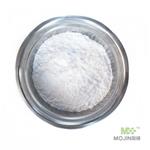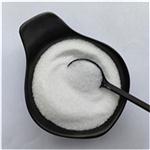Chemical Properties
Ti
3O
5: (1) Rel.molar
mass (Mr
): 223.0070; (2) wt.% Ti: 64.1; (3) Color: Dark blue; (4) crystal lattice structure: dimorphic (120°C)
Low T: Anasovite-type I Monoclinic, C2/m, Z = 4
a = 975.2 pm; b = 380.2 pm; c = 944.2 pm; β = 91.55° High T: Pseudobrookite (orthorhombic); (5) ρcalc. = 4900 kg.m
–3, m.p. = 1777°C
Preparation
Anosovite can be prepared in
the following ways:
(i) By the hydrogen reduction of solid TiO
2
at temperature around 1300°C16 according to
the following reaction scheme:
3TiO
2(s) + H
2(g) —> T
3O
5(s) + H
2O(g) (1300°C).
(ii) By mixing intimately stoichiometric quantities of titanium metal and titanium dioxide
in an electric-arc furnace under an argon atmosphere according to the following reaction scheme:
5TiO
2(s) + Ti(s) —> 2Ti
3O
5(s) (1150°C)
followed by annealing in a vacuum of the crushed material for 2 weeks at 1150°C in
a sealed silica tube. This oxide is dimorphic with a rapid phase transition from semiconductor to metal occurring at roughly 120°C. α-Ti
3O
5—> β-Ti
3O
5
(120°C).
The low-temperature form (α-Ti
3O
5), also called anosovite type I, crystallizes with a monoclinic unit cell with the Ti-O bond distances ranging from 178 to 221 pm. The structure can
be described in terms of TiO6
8– octahedra joined by sharing the edge and corners to form an
infinite three-dimensional network. Anosovite I is obtained by the hydrogen reduction of
pure rutile at 1300°C. The high-temperature form (β-Ti
3O
5), also called anosovite type II, is
a slightly deformed pseudobrookite structure (AB
2O
5) with the Ti-O bond distances ranging
from 191 to 210 pm. The type II is obtained by hydrogen reduction at 1500°C with magnesia
as a catalyst. The anasovite type II is similar to that identified in titanium slags. It can be
stabilized at room temperature with a small amount of iron.





